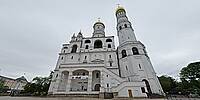
The oldest square of the Kremlin
Cathedral Square, Moscow, Russian Federation
May 2, 2025 - 8:34 GMT+0
© 2025 Andrew Varlamov, All Rights Reserved.
Cathedral Square is the historical and architectural center of the Moscow Kremlin. It occupies the highest part of the Kremlin hill. The square is surrounded by the Palace of the Facets and the Patriarchal Chambers, Cathedral of the Dormition, Cathedral of the Archangel, Cathedral of the Annunciation, the Church of the Deposition of the Robe, Ivan the Great Bell Tower and other buildings.
The layout of the square was formed in the 14th century. At that time, Cathedral of the Dormition, Cathedral of the Archangel, and the Church of St. John Climacus with bells were built. Later, Cathedral of the Annunciation appeared, adjoining the Grand Duke's palace, and in the middle of the 15th century, the Church of the Deposition of the Robe. The original appearance of these buildings has not survived to this day.
The square's current appearance was created in the late 15th - early 16th centuries, when cathedrals and churches were rebuilt. The Palace of the Facets was erected, and the Ivan the Great Bell Tower appeared in place of the Church of St. John Climacus. In addition, the eastern facade of the Tsarina's Golden Chamber and the Church of the Deposition of the Robe , the home church of the Moscow metropolitans and patriarchs, overlook the Cathedral Square.
Many of the buildings on Cathedral Square were built by Italian architects: Aristotele Fioravanti, Aloisio the New, Bon Fryazin, Petrok Maly, Marco Fryazin, Pietro Antonio Solari. Therefore, its appearance was greatly influenced by the architecture of the Italian Renaissance.
Over the centuries-long history of Cathedral Square, its appearance has changed dramatically more than once. Initially, mainly wooden cathedrals, churches and civil buildings were erected along the perimeter of the central square of the Kremlin. Some of them perished in the flames of numerous Moscow fires, others fell into disrepair over time, and new ones were erected in their place. Almost all of the churches that currently exist on the square had earlier predecessors. The original Assumption (built in 1326), Archangel (1333) and Annunciation Cathedrals (1397-1416), the Church of the Deposition of the Robe (1451), the old Patriarchal Chambers, the Church of the Solovetsky Miracle Workers have not survived to this day.
There were also buildings that were damaged and destroyed intentionally. This happened during the Time of Troubles and during Napoleon's invasion in 1812, when the retreating French army destroyed the original Filaretov extension to the Ivan the Great Bell Tower. Its fate was shared by the three-span belfry built near the bell tower by Petrok Maly.
The Church of St. John Climacus, which was dismantled in the 15th century to make way for the construction of the Ivan the Great Bell Tower, has not survived to this day. In 1812, the belfry adjacent to this bell tower was blown up, and in 1814-1815 it was restored by Domenico Gilardi according to the design of Ivan Egotov and Luigi Rusca. In 1930, by order of Joseph Stalin the Red Porch of the Faceted Chamber was demolished, and restored in 1994.
The Moscow Kremlin, on whose territory the square is located, is a closed site for archaeologists because it houses government bodies. The Kremlin cannot be called a sufficiently studied monument: before the revolution, no one was engaged in archaeological excavations, because the territory was built up, and the monasteries were active. And after the revolution, the Kremlin became a "regime" object. Aspects of the formation of the ancient settlement on Borovitsky Hill remain unclear. The main source of archaeological materials were not excavations with the complete opening of ancient structures, but observations and recording of the cultural layer during economic and engineering work - for Moscow, the growth of the layer is one centimeter per year.
Nevertheless, archaeologists have managed to discover the first settlements on the territory of the Moscow Kremlin, dating back to the Bronze Age (2nd millennium BC). Near the modern Cathedral of the Archangel, a Finno-Ugric settlement was found, dating back to the early Iron Age (second half of the 1st millennium BC). At that time, the Dyakovo-type population occupied the center of the upper floodplain terrace of Borovitsky Hill - the area of today's Cathedral Square - and may have already had fortifications.
The square was paved very early, but traces of ancient pavements are very insignificant - they practically disappeared after numerous reconstructions. Fragments of brick and white stone pavement from the end of the 15th century were found near the Cathedral of the Dormition. Wooden pavements are mentioned in the information about the fire of 1737. In the 18th and 19th centuries, Cathedral Square was covered with slabs of hard sandstone several times. The existing solid stone pavement begins in 1913. At the beginning of the 20th century, the square was cleared of the accumulated cultural layer, and in the 1930s it was paved with asphalt. In 1955, the asphalt was removed and the previous stone covering was restored.
Lat: 55° 45' 2.524" N
Long: 37° 37' 3.35" E
Precision is: Medium. Nearby, but not to the last decimal.
Camera: Pentax K-5 II; Lens: Samyang 8mm f/3.5 UMC Fish-eye CS II; Hot shoe two axis double bubble spirit level: ROWI 197;Cable switch: CS-205; Shooting without tripod manual by Nuno A. Madeira (Portugal); PC Software: PTGui Pro 10.0.19 by New House Internet Services B.V. (dated by June 6, 2018), Pano2VR 6.1.8 pro 64bit by Garden Gnome Software (dated by May 25, 2020)
Despite the warm weather in the second half of April (when trees and flowers began to bloom), Moscow was hit by snowfall on the very first evening of May. By morning the snow on the streets had melted or been cleared away, the remaining snow can be seen on the domes of the Cathedral of the Annunciation. Due to the sudden cold snap, the number of visitors of the Kremlin decreased so much that it was possible to take a panorama of the square by hand. The sun did not come out from behind the clouds, so the lighting can be considered ideal.
I would like to acknowledge my wife, daughter and granddaughter, without whom our trip to Moscow for the holidays would not have happened.


 Tap or click the zoom icon in the bottom right corner of the picture to switch between in-page and fullscreen view
Tap or click the zoom icon in the bottom right corner of the picture to switch between in-page and fullscreen view